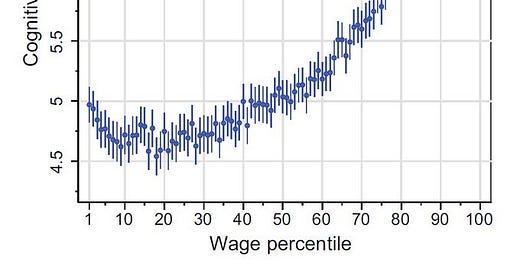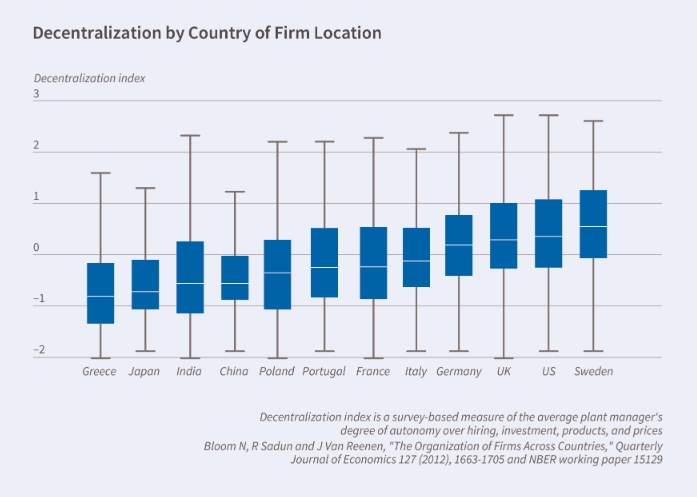Perspective on Risk - July 20, 2023 (Leadership)
Simple Advice; Bad Mgt. Increases Costs; Most Capable Are Not Rewarded; Shut Up Already; Why Would You Hire This Person? Nudges; Unicorns; Drunk Crowds; Bias Against The Last Person Interviewed; CEOs
Hope everyone is having a nice summer.
For those new to the Substack, once or twice a year I like to share research on leadership that I’ve come across. Many of these were first highlighted on Prof. Ethan Mollick’s twitter feed. Here are some past Perspectives on leadership:
Simple Advice
Having dinner with some former collogues, I was reminded the other day of the career guidance I gave out. It was pretty simple.
Don’t be a dick
Don’t work for a dick
Bad Management Increases Attrition Costs
People Management Skills, Employee Attrition, and Manager Rewards: An Empirical Analysis
Replacing a manager at the 10th percentile of people management skills with one at the 90th percentile reduces the total subordinate labor costs by 5% solely from lower hiring costs due to less attrition.
To often firm’s fail to evaluate the management and leadership performance of their leaders and managers. Big miss.
Regularly Debrief
We’ve all done a debrief, or an after-action review. However, I’d bet that most of us did not do them regularly. Maybe we debriefed after something went wrong. But research shows that you should regularly debrief; make it standard practice.
Debriefs: Teams learning from doing in context. ($)
Well-conducted debriefs can improve team effectiveness by 25% across a variety of organizations and settings.
For example, the U.S. military adopted debriefs decades ago to promote learning and performance across the various services. Subsequently, debriefs have been introduced in the medical field, the fire service, aviation, education, and in a variety of organizational training and simulation environments.
After a discussion of various purposes for which debriefs have been used, we proceed with a historical review of development of the concepts and use in industries and contexts. We then review the psychological factors relevant to debrief effectiveness and the outcomes for individuals, teams, and organizations that deploy debriefs.
Team Performance Is Not Normally Distributed
Team Performance: Nature and Antecedents of Nonnormal Distributions
Only 11% of the distributions were normal, star teams are much more prevalent than predicted by normality, the power law with an exponential cutoff is the most dominant distribution among nonnormal distributions (i.e., 73%), and incremental differentiation (i.e., differential performance trajectories across teams) is the best explanation for the emergence of these distributions.
Second, this conclusion remained unchanged after examining theory-based boundary conditions (i.e., tournament versus nontournament contexts, performance as aggregation of individual-level performance versus performance as a team-level construct, performance assessed with versus without a hard left-tail zero, and more versus less sample homogeneity).
Third, we used the team learning curve literature as a conceptual framework to test hypotheses and found that authority differentiation and lower temporal stability are associated with distributions with larger performance variability (i.e., a greater proportion of star teams).
Implications for Practice
Because of the heavy-tailed nature of the team performance distribution, there is an important distinction between the performance of star teams and that of others. This finding suggests a need to implement proper compensation practices that reflect the very large variability in performance across teams. Creating compensation packages focused on spurring equitable, team-based pay that helps distinguish teams can help managers reward top performing teams and motivate other teams to reach higher performance levels. This is especially true if the rewards are based on equity, and there is transparency in the compensation plan (Aguinis and Bradley 2015).
In addition, in the presence of heavy-tailed distributions, the resource allocation-performance and performance-value functions are not linear (Trevor et al. 2012, Hill et al. 2017). Accordingly, if the goal is to increase an organization’s overall performance, return on investment (ROI) will be greater when resources are allocated to star teams.
The Most Cognitively Capable People Are Not Rewarded (in Sweden)
The plateauing of cognitive ability among top earners (Marginal Revolution)
Are the best-paying jobs with the highest prestige done by individuals of great intelligence?
Past studies find job success to increase with cognitive ability, but do not examine how, conversely, ability varies with job success. Stratification theories suggest that social background and cumulative advantage dominate cognitive ability as determinants of high occupational success. This leads us to hypothesize that among the relatively successful, average ability is concave in income and prestige. We draw on Swedish register data containing measures of cognitive ability and labour-market success for 59,000 men who took a compulsory military conscription test.
Strikingly, we find that the relationship between ability and wage is strong overall, yet above €60,000 per year ability plateaus at a modest level of +1 standard deviation. The top 1 per cent even score slightly worse on cognitive ability than those in the income strata right below them. We observe a similar but less pronounced plateauing of ability at high occupational prestige.
Shut Up Already
I’ve worked with a lot of people who like to hear themselves talk.


Why Would You Ever Hire This Person?
I don't have hobbies
I don't believe in weekends
The only thing I love more than emails and spreadsheets is meetings about emails and spreadsheets
Uggh.
McKinsey on Corporate Nudges
If you’ve worked with me, you know I have long lamented the time and money wasted on failed corporate initiatives. Many have failed due to changing management or management priorities. Others, though, fail because of culture or poor incentives.
Your organization is lavishing time and money on ambitious corporate transformation programs. Yet none of them have made a dent in employee behaviors, which will need to change for the organizational transformation to succeed.
McKinsey has published a set of useful pieces in their Leading Off. It has some very useful insights into incorporating behavioral science into management initiatives.
To effect visible change, leaders may want to take a closer look at behavioral science (also known as behavioral economics or behavioral insights), which applies findings from psychology, economics, sociology, and other disciplines to understand how people behave and make decisions in real life. An aspect of behavioral science called “nudging”—using subtle interventions to steer people in a specific direction without limiting their options—has been successfully applied in both public- and private-sector settings.
There is enough reading and insights here to last you a very long time. I particularly liked the discussion of recognizing and avoiding institutional and personal biases.
Identify the Unicorns
Nate Silver discusses Nicola Jokic in The Nuggets were hiding in plain sight
The NBA forecasting system I developed — originally called CARMELO but now rebranded as RAPTOR — is based on identifying similar players throughout NBA history. The Boston Celtics’ Jayson Tatum, for instance, entered this year with a profile similar to Marques Johnson, Carmelo Anthony, Paul Pierce, Terry Cummings, Kevin Durant, among others.
With Jokic, on the other hand, RAPTOR has no idea what to do. It can’t find any other players like him. Based on the scale I developed, a perfect similarity score — two literally identical players — is 100. In practice, however, any players with a score of 30 or above are reasonably similar, and players 50 or above are very similar. Johnson gets a 60 similarity score to Tatum, for example, while Anthony has a 56 and Pierce a 49.
In Jokic’s case, however, no player entered the season with a similarity score higher than … 4. That score actually belongs to Embiid. Only three players — Embiid, Anthony Davis and Garnett — even had a positive score at all, while LeBron James had a zero. In this system, a zero marks the dividing line; a score below zero means that a player is more dissimilar than similar. So in the entire history of the NBA5, all but four players are more dissimilar to Jokic than similar to him, and the other four are just barely on the other side of the line.
The Wisdom of Crowds Works Even When The Crowd Is Drunk
Groupdrink : the effects of alcohol and group process on vigilance errors
Two hundred and eighty-six undergraduates with normal drinking habits undertook a vigilance task alone or in four-person groups having consumed either alcohol (calculated to achieve up to .08 blood alcohol content) or a placebo. The vigilance task required them to count occurrences of the word “the” in a spoken passage. Alcohol significantly impaired the performance of individuals but not groups. Group members performed at a similar level in both conditions, making fewer errors than individuals in the alcohol condition. The fit of different decision-making models were tested. In both the alcohol and placebo conditions, group consensus was predicted by processes consistent with the group monitoring hypothesis. The evidence highlights that under certain conditions, group process can compensate for the cognitively impairing effects of alcohol on individuals.
Another Reason To Avoid Relying On Interviews
If you’ve been following me for any length of time, you’ve seen me present constant evidence that the traditional interviewing process is not only ineffective, but tends to be discriminatory. Here’s yet more evidence.
ARE WE BIASED AGAINST THE LAST PERSON WE INTERVIEW?
A recent study from Chicago Booth … suggests that we might suffer if we’re the last person to be interviewed. The authors argue that when evaluated sequentially, we’re more likely to judge those coming last more harshly.
CEO Performance
This summary describes recent empirical work that I have conducted to generate direct evidence on what top managers do, how they differ from one another, and whether these differences matter for firms’ performance.
First, top managers vary considerably in what they do, both in terms of day-to-day behaviors (effort on the job, allocation of time across activities) and decision-making approaches (specifically, the formulation and execution of firm strategies).
Second, CEOs also differ in terms of what they do not do, that is, the extent to which they allocate decision-making authority to other individuals in their organizations.
Third, differences across CEOs in both activities and delegation are related to organizational performance, primarily due to matching effects.
We find that leader behavior is more common in large firms, multinationals, listed firms, and in sectors with high R&D intensity and production processes denoted by a higher incidence of abstract, rather than routine, tasks. We also find that leader behavior is more likely to be found in more productive and profitable firms. The correlation is economically and statistically significant:
Firms in higher-trust regions are more decentralized and larger, and CHQ trust also predicts the level of delegation in subsidiaries, even when they are located in other regions or countries. … these results suggest that external forces, and in this case some specific aspects of culture, may have powerful effects on CEOs’ willingness to delegate and, ultimately, on firm structure.
The Universe Is Not Real (At Least Not Locally)
Not really leadership or management, but moderately mind-blowing.
The Universe Is Not Locally Real, and the Physics Nobel Prize Winners Proved It
One of the more unsettling discoveries in the past half a century is that the universe is not locally real. In this context, “real” means that objects have definite properties independent of observation—an apple can be red even when no one is looking. “Local” means that objects can be influenced only by their surroundings and that any influence cannot travel faster than light. Investigations at the frontiers of quantum physics have found that these things cannot both be true.
This is, of course, deeply contrary to our everyday experiences.
To adapt a phrase from author Douglas Adams, the demise of local realism has made a lot of people very angry and has been widely regarded as a bad move.




